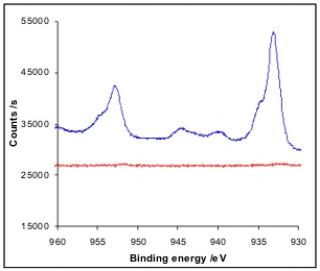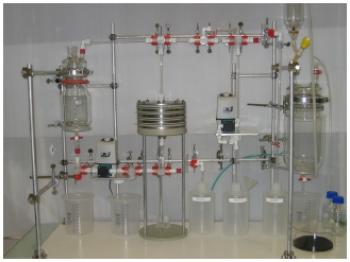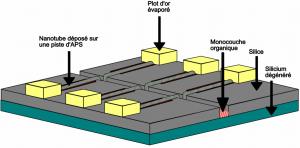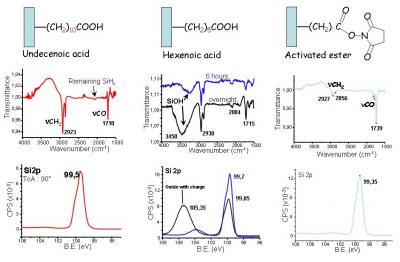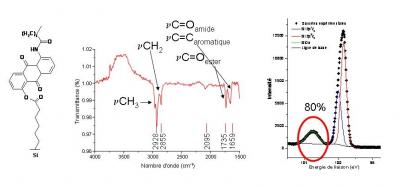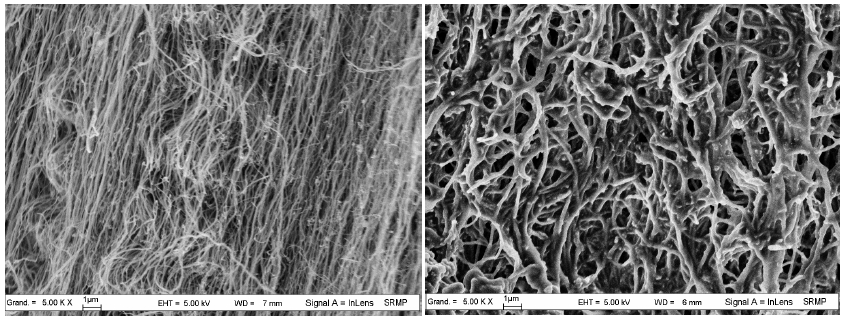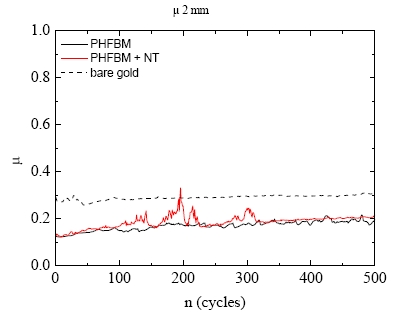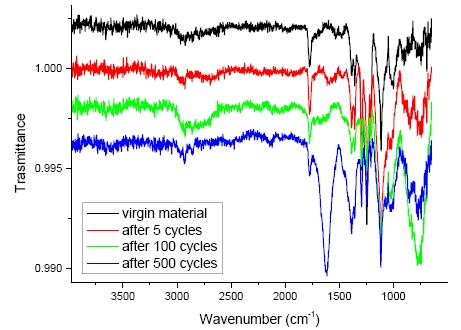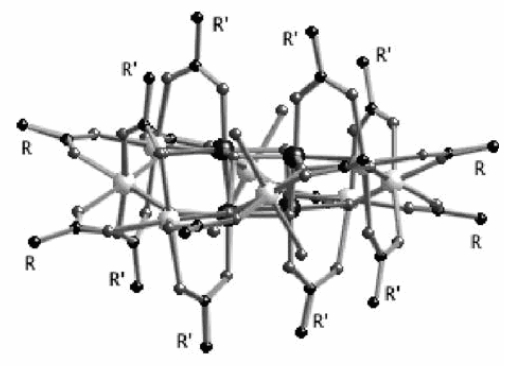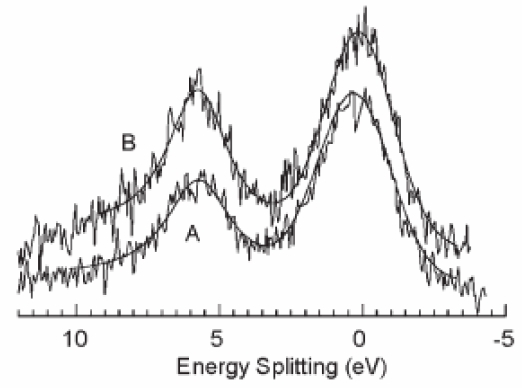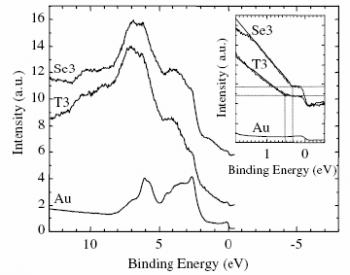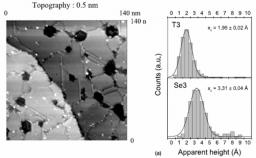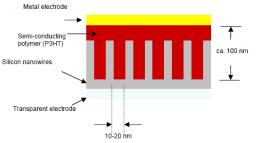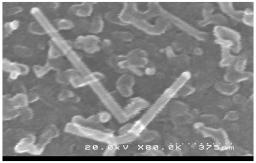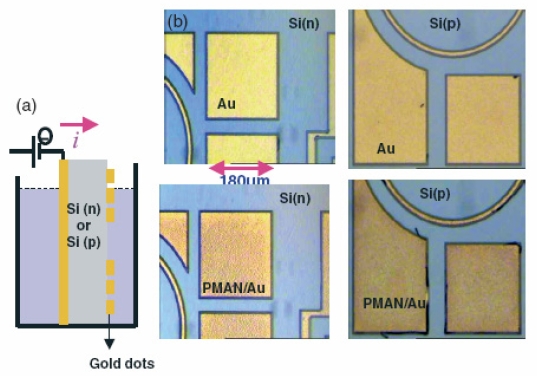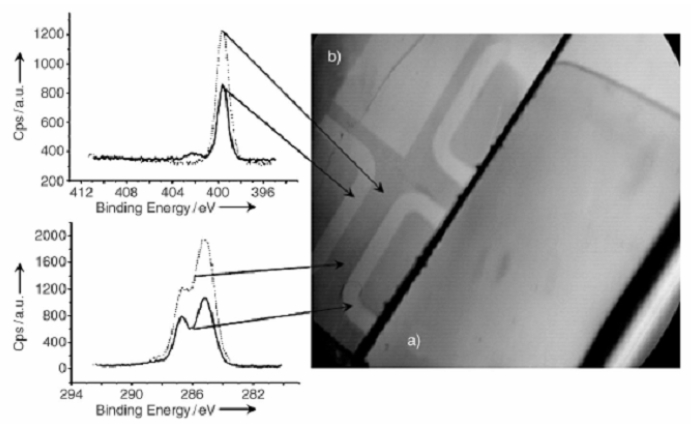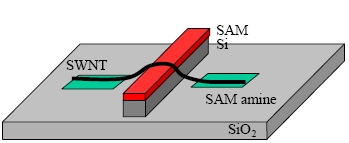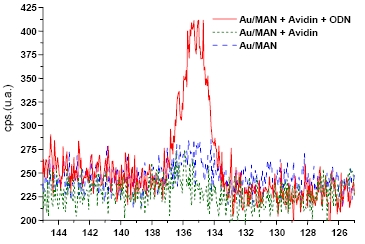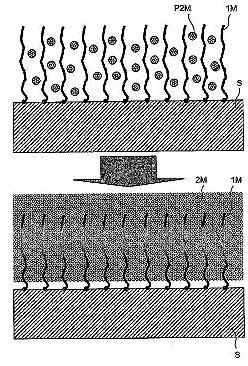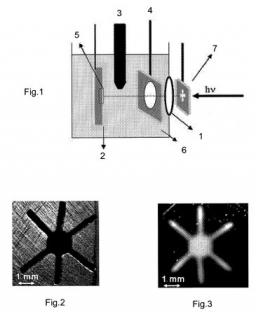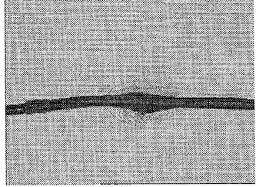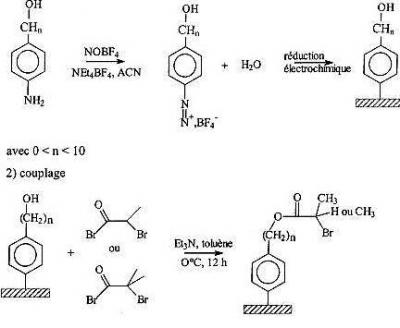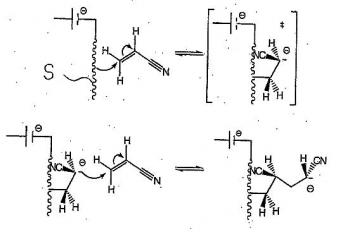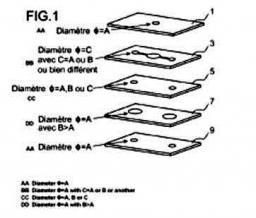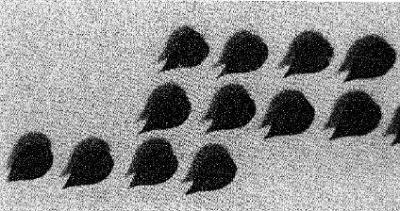

Localized electrografting of polymer on gold using the tip of a Scanning Electrochemical Microscope as a pencil. The black bar is 100 microns.
Any material, of stainless steel to the liposomes, the polymer prostheses to carbon fibres interacts with its environment by its surface. Adhesion, corrosion, lubrication, the electrical contact, the biocompatibility or damping are as many current phenomena controlled by surface effects. The alive systems, them also, are the seat of innumerable phenomena of interface located in the lipidic bilayers or on the external surface of proteins. It is thus crucial, at the same time on the fundamental level and the technological level, to know to conceive and build artificial surfaces able to interact with the medium external in a preset way. The Chemistry group of Surfaces and Interfaces devotes its activity in this field, by studying the control of the interfaces matter mineral organics-surface, the latter coming from metals, semiconductors, insulators or carbonaceous materials. Our fields of intervention go from the processes of depollution to micro-electronics, of adhesion to the local electrochemical phenomena, biocompatible surfaces to molecular electronics, photovoltaic cells and fuels cells.
We use primarily electrochemistry to modify conducting material surfaces (which play the role of electrodes during the grafting). Indeed, the injection of electrons starting from conducting surface towards a solution of idoines electroactives molecules leads to the formation of strong covalent bonds between the surface of the electrode and the molecules: we name this process "electrogreffage"; it acts in fact of a cathodic grafting electro-armature, often accompanied by polymerization of an anion type starting from the grafted precursor. The mechanism of this grafting could be deduced from multiple in situ characterizations and ex situ. In parallel, the group was interested in the applications of these grafted organic films and two startups were spin-off from our group, in 2001 and 2009.
Contact: Serge Palacin
Recent publications :
1. Le Goff, A.; Artero, V.; Jousselme, B.; Dinh, P. T.; Guillet, N.; Métayé, R.; Fihri, A.; Palacin, S.; Fontecave, M. ; From Hydrogenase Mimics to Noble-Metal Free Hydrogen-Evolving Electrocatalytic Nanomaterials; Science 2009, sous presse.
2. Ghorbal, A.; Grisotto, F.; Charlier, J.; Palacin, S.; Goyer, C.; Demaille, C.; Localized electrografting of vinylic monomers on conducting substrate using an integrated electrochemical AFM probe. ChemPhyschem 2009, 10, 1053-1057.
3. Le, X. T.; Viel, P.; Jégou, P.; Palacin, S.; Electrochemical-switchable polymer film: an emerging technique for treatment of metal ion waste water; Separation Purification Tech. 2009, 69, 135-140.
4. Tessier, L.; Deniau, G.; Charleux, B.; Palacin, S.; Surface Electroinitiated Emulsion Polymerization (SEEP): A mechanistic approach; Chem. Mater. 2009, 21, 4261–4274.
5. Viel, P.; Le, X. T.; Huc, V.; Bar, J.; Benedetto, A.; Le Goff, A.; Alamarguy, D.; Noël, S.; Baraton, L.; Palacin, S. ; Covalent grafting onto self-adhesive surfaces based on aryldiazonium salt seed layers; J. Mater. Chem. 2008, 18, 5913 - 5920.
6. Charlier, J.; Palacin, S.; Leroy, J.; Del Frari, D.; Zagonel, L.; Barrett, N.; Renault, O.; Bailly, A.; Mariolle, D., Local silicon doping as a promoter of patterned electrografting of diazonium for directed surface functionalization. J. Mater. Chem. 2008, 18, 3136-3142.
7. Mévellec, V.; Roussel, S.; Tessier, L.; Chancolon, J.; Mayne-L'Hermite, M.; Deniau, G.; Viel, P.; Palacin, S., Grafting polymers on surfaces: A new powerful and versatile diazonium salt-based one-step process in aqueous media. Chem. Mater. 2007, 19, 6323-6330.
8. Lenfant, S.; Guérin, D.; TranVan, F.; Chevrot, C.; Palacin, S.; Bourgoin, J. P.; Bouloussa, O.; Rondelez, F.; Vuillaume, D., Electron transport through rectifying self-assembled monolayer diodes on silicon: Fermi level pinning at the molecule-metal interface. J. Phys. Chem. B 2006, 110, 13947-13958.
9. Deniau, G.; Azoulay, L.; Jegou, P.; Le Chevallier, G.; Palacin, S., Carbon-to-metal bonds: Electrochemical reduction of 2-butenenitrile. Surface Science 2006, 600, 675-684.
10. Palacin, S.; Bureau, C.; Charlier, J.; Deniau, G.; Mouanda, B.; Viel, P., Molecule-to-metal bonds: electrografting polymers on conducting surfaces. ChemPhysChem 2004, 10, 1468-1481.
Vous devez préciser l'id_ast dans la table des unités.


